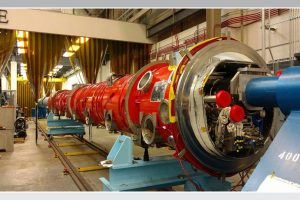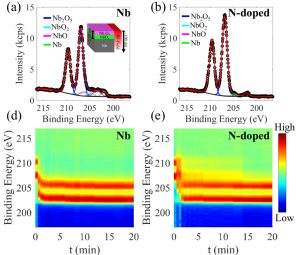Superconducting radio frequency (SRF) resonator cavities are currently used in particle accelerators to accelerate and control beams of charged particles in high energy collision experiments (such as at the Large Hadron Collider at CERN) or in x-ray lasers (such as at the Coherent Light Source at SLAC).

Assembling of cryomodule at Jefferson Lab
The limiting accelerating fields and mechanisms of power loss in superconducting cavities are not well understood. Increasing the accelerating fields and reducing power consumption of SRF cavities is essential for the development of the next generation of accelerators, as well as for upgrades of existing facilities.
Our main task is understanding the fundamental physical and materials science mechanisms behind optimization of the state of the art Nb cavities and investigating new structures and superconducting materials for cavities.
Superconducting Properties of Nitrogen-Doped Niobium Resonator Cavities

XPS Nb 3d spectral line and XPS depth profile for Nb and N-doped Nb cutouts from SRF cavities.
Scanning tunneling spectroscopy and X-ray photoemission spectroscopy measurements have been used to address for the first time the fundamental materials science mechanisms behind the striking microwave suppression of the nonlinear surface resistance resulting from the nitrogen doping of the state-of-the-art Nb resonators. The results suggest that the N-doping slightly reduces the superconducting gap while significantly reducing spatial inhomogeneities. Furthermore, it changes the native oxide layer by reducing the metallic suboxide and by changing the interface contact resistance. This work shows how superconducting properties at the Nb surface could be tuned by impurities to reduce the RF losses. Besides addressing the fundamental limits of RF dissipation in superconductors, these results can be important for energy and IT applications, particularly, the ultrahigh-Q resonant cavities for high-energy particle accelerators and superconducting microcavities for quantum computing, where an effort in the materials science of Nb and Nb processing is necessary to further improve the coherence times and facilitate scalability. Physical Review Applied, 13(4), 044044 (2020)
